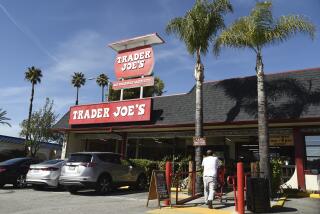Golf Just Trying to Stay in Play
- Share via
When Bob Hutchinson is in the market for golf equipment, he shops around, comparing prices at every place that sells clubs, from the numerous merchants online to the many specialty retail stores in Los Angeles.
The 60-year-old avid golfer ended up purchasing his newest driver, a $399 Titleist, at a pro shop on the course in Griffith Park, where he frequently plays.
“I’m not a loyal customer of one place,” Hutchinson said early one morning after a round at Harding/Wilson Municipal Golf Course.
That makes him exactly the type of customer Golfsmith International Inc. wants to lure as it tees off on a major expansion in Southern California, where the competition is as tough as a 500-yard par-five hole.
Golfsmith’s move comes at a time when the $6-billion golf retail industry is barely growing, hurt by a soft economy, unusually wet golf seasons in recent years and waning interest in the sport by amateurs.
Nationwide, rounds of golf played last year fell 3% from 2001, continuing a downward trend that began in 2000. Through April of this year, rounds dropped 2% nationally, according to market research firm Golf Datatech, and 4.8% in Los Angeles County.
The playing slump has produced lackluster demand for new equipment. Last year, for instance, U.S. sales of club sets dropped 20% to $1.6 billion, the National Sporting Goods Assn. said, while golf ball sales were down 2.3% to $893 million. Likewise, combined sales of bags, gloves and shoes fell 5.8% to $952 million, according to the National Golf Foundation, an industry trade group.
These days, “we don’t need new competitors,” said Al Morris, president of Worldwide Golf Enterprises Inc., which operates nine Roger Dunn Golf Shops and has two franchise operations in the Southland.
“Business is tough as it is,” Morris said. “Our business is good, but it’s not like it was in the early to mid-’80s, where you just would have to open a store and you’re successful.”
Part of the problem for Roger Dunn and other specialty retailers: A sagging economy has cut consumers’ desire to buy discretionary goods. Many are trading down, buying low-priced equipment.
“There’s a lot of clubs you could get in Kmart,” said Alexander Paris, an analyst with Barrington Research Associates. “When you talk about Titleist and Callaway, you’re talking about $300 or more; it’s big spending.”
Golf retailers and manufacturers know the sluggish golf business all too well.
Pro Golf of America Inc., which supports 140 franchise stores in the U.S. and Canada, saw its April same-store sales slip 6% compared with the same period last year, despite a double-digit increase in revenue at its 11 California stores, President and Chief Operating Officer Joseph J. White said.
“We had an enormous amount of inclement weather east of the Mississippi,” White said. “Golf is a game that’s impacted by the weather.”
Even club maker Callaway Golf Co., which posted a 38.4% jump in first-quarter earnings and a 5.8% increase in sales, cautioned that the start of the spring golf season may not provide the usual lift in revenue because of low consumer confidence caused by the war in Iraq and severe acute respiratory syndrome.
“We had a very good first quarter, but there might be factors at play that could change the dynamics,” said Larry Dorman, the Carlsbad, Calif.-based company’s spokesman. “One of them being weather, which is unpredictable and outside of our control. We projected a flat year.”
Golfsmith International fared much worse. In the three months ended March 29, the Austin, Texas-based company had a net loss of $1.2 million as sales dropped 5.4% to $45.8 million, according to a recent Securities and Exchange Commission filing. The retailer is privately held but reports financial results because some of its debt is publicly traded.
Still, Golfsmith, with 28 stores in 11 states, sees greener fairways. The retailer is betting it can grab hold of the fragmented golf industry and establish itself as a national chain, in part by opening at least four new stores in Los Angeles and Orange counties within the next few years.
The strategy isn’t completely off course, analysts say. Either retailers pull back and ride through difficult financial times, or “they see the downturn and tough time as an opportunity to capture more market share,” said George Whalin, president of San Marcos, Calif.-based research firm Retail Management Consultants.
With stores already in Ontario, Woodland Hills and Pasadena, Golfsmith opened a 15,000-square-foot superstore in Santa Ana this month. A fifth store in El Segundo will open in July.
The company has found a site for a sixth store and is eyeing a seventh location somewhere in the Los Angeles market, said Golfsmith Chief Executive Jim Thompson.
Golfsmith began in 1967 as a company that sold custom-fit club components. It expanded into the catalog business selling golf accessories, and established its first retail store in 1992. Its online store came six years later.
Last year, the company, which posted sales of $220 million in 2002, sold its majority stake to First Atlantic Capital Ltd. of New York to fund its expansion. Golfsmith plans to spend $5 million to $7 million to open new stores or renovate existing ones in fiscal 2003, according to the SEC filing.
“Our focus clearly is to be a leader in key marketplaces, and again, California in general is a top golf market,” Thompson said. “If you’re going to be a successful national retailer, you need to be successful here.”
In order to do that, Golfsmith must compete against such well-known regional retailers as Santa Ana-based Roger Dunn. There also is competition from sporting goods stores, pro shops and mom-and-pop operations, though industry consolidation has squeezed out weaker ones.
Some companies have entered the Southern California market, and failed. Morris of Roger Dunn pointed to the demise of Virginia-based Washington Golf Centers, which closed four stores in California in 1997.
“They came out very aggressive with four big stores, and they ended up packing and going home,” Morris said. “I’m not saying that that’s what Golfsmith will end up doing, but only time will tell.”
Although the sport saw a resurgence in the mid-1990s with the much-publicized play of Tiger Woods, and most recently, Annika Sorenstam, the growth of golf has been slow in recent years. The number of golfers who play at least one round a year has remained steady at 26 million in the last few years, according to golf analysts.
“Golf is a luxury sport,” Whalin said. “You need to have some money, and you need to give up four to five hours. It has limited appeal.”
Sam Sheagren, Callaway’s director of global sales operations, said the manufacturer would like to see all golf retailers succeed in Los Angeles. Nevertheless, Sheagren acknowledged that the area “is a very competitive market right now. It’s hard to say if there’s room or not. We certainly hope so.”
In Los Angeles and elsewhere, Golfsmith plans to leverage its retail, catalog and online businesses, custom club-making department and proprietary golf brands such as Zevo and Lynx in the mid-cost range to boost market share.
“I do know that if you allow customers to shop anywhere they want, you could win,” Thompson said. “We understand the economics of our catalog and Internet businesses.”
After cutting back on its catalog circulation in the first quarter because of global uncertainties, Thompson said Golfsmith, since April, has been redeploying cash and resources to boost its circulation.
As Golfsmith expands nationwide, its purchasing power could increase, possibly lowering prices for customers, Thompson said.
Unlike some specialty golf retailers, Golfsmith doesn’t consider itself a discount store, but offers sales and promotions as well as a 115% price guarantee. Still, both Golfsmith and Roger Dunn on their Web sites priced Callaway’s Great Big Bertha II Pro Series driver at $399.99.
Meanwhile, golfers such as James L. Crawford of Los Angeles are cutting back their golf playing and spending.
“It’s because of the economy, no doubt,” said Crawford, 59, before he headed off to the greens at Griffith Park earlier this week. “In other words, I can’t play on the weekends because the fees are higher.”
And, he added, “I’m holding off on buying equipment.”
More to Read
Inside the business of entertainment
The Wide Shot brings you news, analysis and insights on everything from streaming wars to production — and what it all means for the future.
You may occasionally receive promotional content from the Los Angeles Times.










